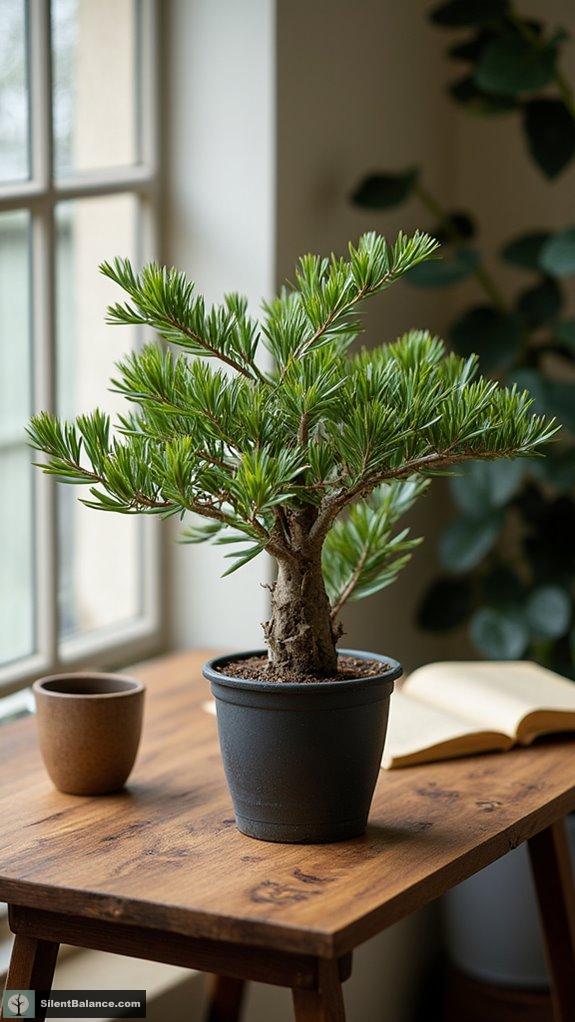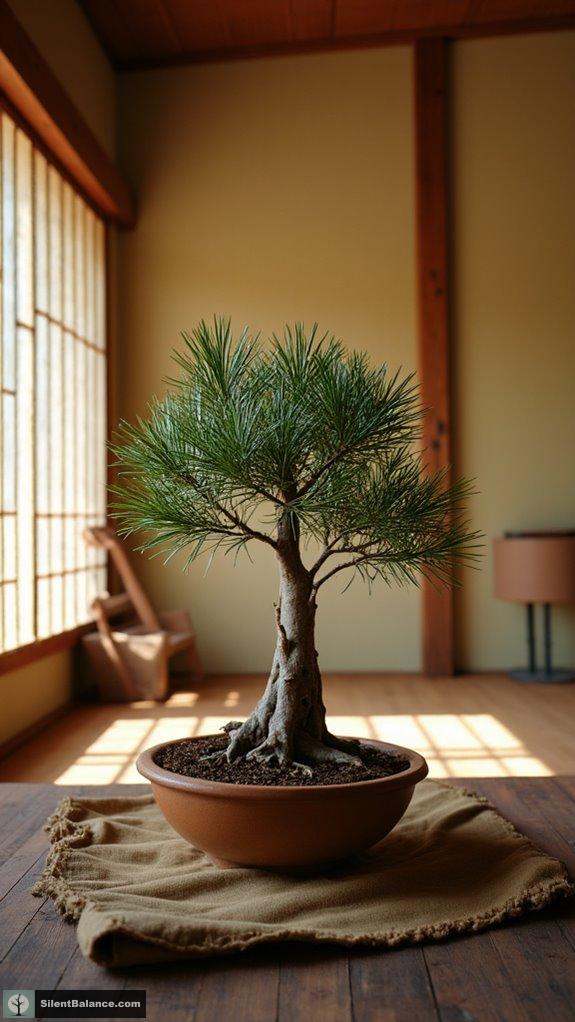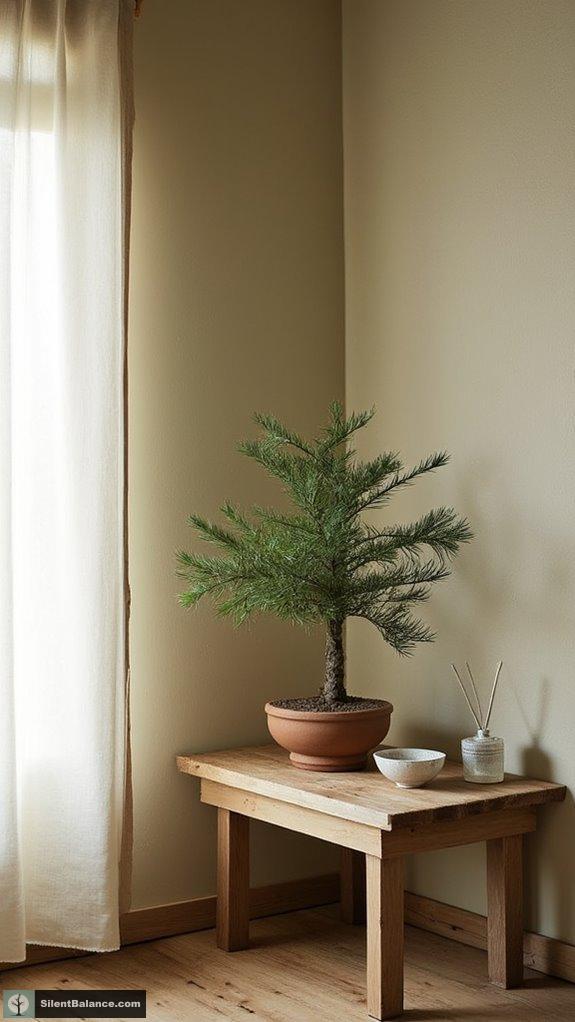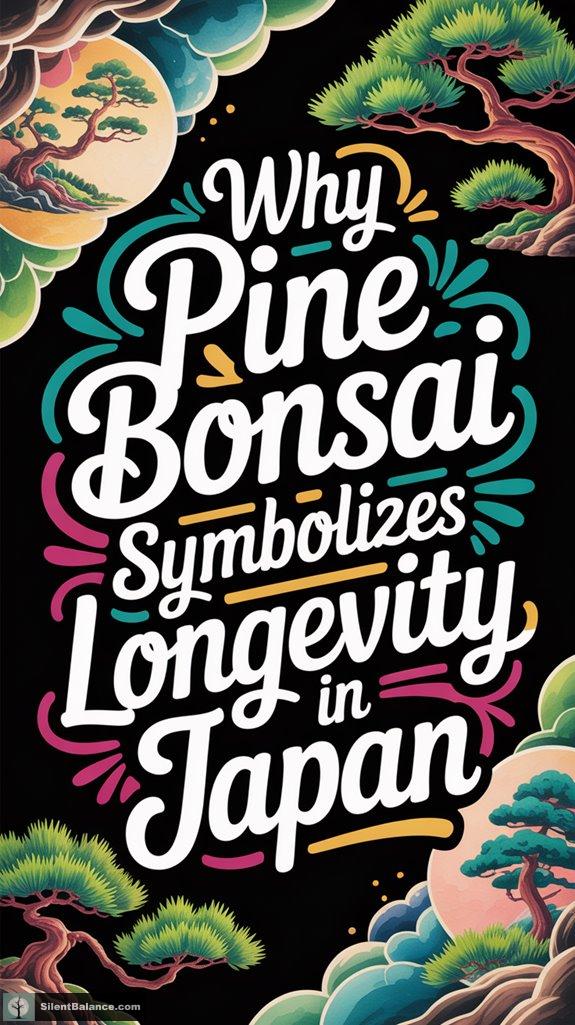Pine bonsai symbolize longevity in Japan because they’re steeped in history, resilience, and spiritual belief. Just think about it—those long, slender needles aren’t just pretty; they represent vigor and strength. The rugged bark? A nod to endurance and protection! Plus, the iconic Yamaki Pine, which survived Hiroshima, is a living proof of this symbolism. Curious about how these amazing trees intertwine with culture and art? Stick around, and there’s much more to explore!
Quick Takeaways
- Pine bonsai symbolize longevity due to their resilience and spiritual connection to divine longevity in Shinto beliefs.
- The rugged bark and long needles of pine advocate strength and endurance, emphasizing their role in Japanese culture.
- Historically significant, the Yamaki Pine endured the Hiroshima bombing, embodying survival and the essence of longevity.
- Each pine bonsai embodies kodama, reflecting the spirit of endurance and protection, integral to Japanese spirituality.
- Aesthetic styles in bonsai design, such as literati and semi-cascade, highlight their connection to nature and longevity ideals.
Symbolism of Longevity in Pine Bonsai

When we talk about pine bonsai, it’s hard not to get swept away by its rich symbolism, especially when it comes to longevity.
Pine bonsai embody resilience and longevity, captivating us with their deep spiritual connections and rich symbolism.
These evergreen beauties embody resilience, don’t they? Tying deeply into Shinto beliefs, the mighty pine, or “matsu,” isn’t just a tree—it’s a spiritual link to divine longevity. You’ll see it in New Year decorations, welcoming prosperity with open branches. Additionally, the pine tree is considered a resting place for the gods’ souls, emphasizing its sacredness in Japanese culture.
And let’s not forget the Yamaki Pine, over 400 years old, a living symbol of endurance.
Isn’t it fascinating how these trees connect us to both nature and our past, echoing strength and hope across generations? Who wouldn’t want that in their life?
Physical Attributes of Pine Bonsai and Their Meanings

Pine bonsai, with its striking silhouette and intriguing details, offers a treasure trove of physical attributes that speak volumes about their symbolism and meaning.
Take those long, slender needles, for instance—don’t they just scream vigor? Grouped in pairs, they present dense clusters that signify strength and resilience.
And what about the rugged bark? It’s like nature’s armor, showcasing endurance and protection.
The robust trunk stands as a powerful statement of stability, while the balanced branches radiate harmony.
These elements collectively whisper tales of longevity—who wouldn’t want such rich symbolism in their space?
You’re not just growing a tree; you’re cultivating a legacy!
Historical Significance of Pine Bonsai in Japanese Culture

You know, the journey of pine bonsai in Japanese culture is downright fascinating.
Introduced in the Nara or Heian periods, bonsai, originally “penzai,” beautifully merges nature and artistry.
Pines, revered for strength and resilience, thrive as symbols of longevity.
Ever met the iconic Yamaki Pine? It survived the Hiroshima bombing, a proof of hope and endurance.
The resilient Yamaki Pine stands as a powerful testament to hope, having survived the devastation of the Hiroshima bombing.
Throughout history, these miniature marvels embody patience, celebrated not just in gardens but in art and poetry.
Do you feel their spiritual essence?
When bonsai roots, it intertwines with Japan’s rich tapestry, showing us that even the smallest trees can carry immense cultural weight and power.
Spiritual and Meditative Aspects of Pine Bonsai

Although many might think of bonsai as just clever miniatures in pots, there’s so much more to the spiritual journey of pine bonsai that truly ignites the soul.
When I cultivate these majestic trees, I feel a deep connection to ancient beliefs and nature’s energy.
Consider the following:
- Each pine bonsai embodies kodama the spirit of endurance and protection.
- Meditative practice helps me connect with renewal and stability.
- Pruning becomes a Zen exercise in patience and focus.
- The timeless beauty of pine inspires my pursuit of spiritual freedom.
Artistic Importance of Pine Bonsai in Bonsai Design

When I think about the artistic importance of pine bonsai, I can’t help but get excited about the dance between nature and craftsmanship.
Consider the literati style—its slender trunk twists elegantly, evoking simplicity. Or the semi-cascade, curving like a wild pine clinging to a cliff. Isn’t that enthralling?
Every branch tells a story of rugged life, showcasing asymmetry and movement, while maintenance techniques like selective decandling sculpt the perfect silhouette.
Imagine the interplay of textured bark and deadwood, whispering tales of resilience.
Isn’t it incredible how we can embody nature’s strength in such a refined, powerful form?
Pine Bonsai in Symbolic Plant Groupings and Their Cultural Roles

Diving into the world of pine bonsai and its cultural roles, I find it fascinating how these evergreens serve far more than just a visual treat in our spaces.
Their significance within symbolic plant groupings really stands out.
- They exude resilience and strength through their evergreen nature.
- As part of the shōhaku group, pines symbolize stability amid life’s changes.
- They perfectly balance the fluidity of seasonal plants.
- Plus, pine bonsai in Japanese gardens emphasizes continuity and renewal, connecting us to nature’s cycles.
Isn’t it empowering to possess a living emblem of longevity right in your space?
Ancient Beauty and Resilience

As I explore deeper into the world of pine bonsai, it strikes me how they beautifully embody both ancient beauty and resilience. Their evergreen nature and longevity symbolically whisper the secrets of endurance through harsh winters, connecting us to dimensions beyond. The teachings from the Bodhi tree underline the importance of honoring nature, reminding us of the interconnectedness of all living beings.
| Ancient Symbolism | Resilient Beauty |
|---|---|
| Immortality in Shinto | Effortless elegance |
| Matsushima Pine’s Survival | Yamaki Pine’s strength |
| Zen aesthetics | Caretakers’ dedication |
Isn’t it incredible how a tiny tree can hold such monumental power? Through careful cultivation, pine bonsai celebrate stability amid chaos, echoing life’s relentless spirit. It’s art, history, and nature in one!
Questions and Answers
How Can I Care for a Pine Bonsai at Home?
Caring for a pine bonsai at home? It’s an art, my friend!
First, water it generously when the soil’s slightly dry, but watch out for root rot—no one likes soggy feet!
Place it in full sun, and consider giving it a cool winter coat when temperatures drop.
Prune those candles for bushy growth and keep an eye out for pests—those little rascals!
Are you ready to nurture your green masterpiece? Let’s do this!
What Is the Best Environment for Pine Bonsai Growth?
Looking to create the perfect haven for your pine bonsai?
First off, give it full sun exposure; that’s where the magic happens! Without those golden rays, your pine’s needles may look like they’re on a stretch—it’s just not chic.
Drainage’s key too; soggy soil is a pine’s worst enemy.
And don’t forget, those hardy guys thrive in a cool climate.
Ever tried a winter mulching? Your bonsai will thank you!
What Tools Are Essential for Bonsai Cultivation?
When diving into bonsai cultivation, you need a solid toolkit.
I swear by a sharp pair of general-purpose shears for daily snips. Concave cutters? Absolutely necessary for clean branch removals. And don’t forget your wire cutters and pliers; they help shape those branches like a boss!
Using a root rake during repotting keeps things tidy, while trusty tweezers grab those pesky dead leaves.
What’s your go-to tool in your bonsai arsenal?
How Long Does It Take to Grow a Pine Bonsai?
Growing a pine bonsai is like cultivating patience, my friend.
You’re looking at a minimum of five years before you can start crafting its silhouette, shaping it into a miniature masterpiece.
Tender seeds sprout slowly, and once you hit that sweet spot of five to eight years, you can work your magic with pruning and wiring.
It’s a journey, really—each twist and turn molding a living art piece right before your eyes!
Who’s in?
Can Pine Bonsai Thrive Indoors or Only Outdoors?
Can pine bonsai thrive indoors? Well, that’s like asking if a goldfish can run a marathon!
While some pine varieties, like Norfolk Island, can handle indoor life, most temperate pines prefer the great outdoors. They crave that full sun and proper chill for dormancy to keep their vibrant energy. If you’re set on keeping one indoors, just know it’ll likely grow slower, and that’s not the ideal vibe for a power plant! Recollect, bonsai thrive on balance!
References
- https://bonsaimirai.com/species/japanese-black-pine-bonsai
- https://wazakurajapan.com/blogs/news/bonsai-for-new-year-decoration-and-meaning
- https://www.bonsai-nbf.org/blog-archive/2025/6/26/the-yamaki-pine
- https://www.ebsco.com/research-starters/sports-and-leisure/bonsai
- https://pacificbonsaimuseum.org/furuzawa-pine/
- https://elenamitokyo.com/japanese-pattern-matsu-pine-tree/
- https://bonsaimirai.com/species/lodgepole-pine-bonsai
- https://bonsai-en.shop/blogs/tree-species-guide/japanese-red-pine
- https://www.britannica.com/plant/umbrella-pine
- https://www.youtube.com/watch?v=bzVnLYD5-OA
- Bonsai Placement Benefits for Room Harmony - November 8, 2025
- Why Use Air Layering to Propagate Bonsai Trees? - November 8, 2025
- 15 Stunning Acorn Wood Wall Art Ideas - November 8, 2025

